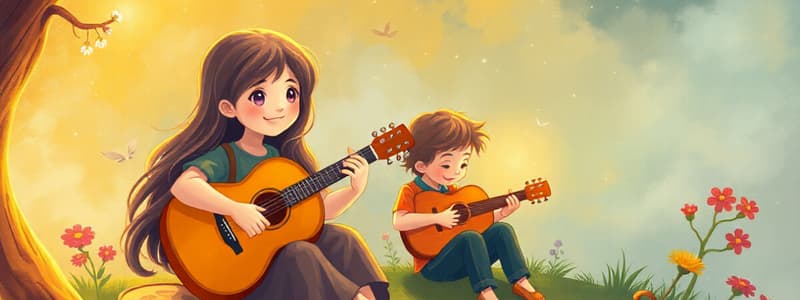Podcast
Questions and Answers
Music and movement activities contribute to social-emotional development primarily because they are solitary experiences that isolate children from a group.
Music and movement activities contribute to social-emotional development primarily because they are solitary experiences that isolate children from a group.
False (B)
Energetic music tends to elevate children's moods and motivate them to engage in physical activity, while calming music has the opposite effect, agitating children.
Energetic music tends to elevate children's moods and motivate them to engage in physical activity, while calming music has the opposite effect, agitating children.
False (B)
Children utilize physical actions to articulate a consistent emotion, such as happiness.
Children utilize physical actions to articulate a consistent emotion, such as happiness.
False (B)
Sharing a song or dance that a child has learned at home may lead them to feel negatively about themselves and their cultural identity.
Sharing a song or dance that a child has learned at home may lead them to feel negatively about themselves and their cultural identity.
Cooperation and teamwork are not teachable skills, therefore musical games will not develop social skills.
Cooperation and teamwork are not teachable skills, therefore musical games will not develop social skills.
According to environmental guidelines, musical and movement-based activities should be presented daily for free choice.
According to environmental guidelines, musical and movement-based activities should be presented daily for free choice.
The incorporation of dance costumes into a child's learning environment is recommended weekly, according to environmental guidelines.
The incorporation of dance costumes into a child's learning environment is recommended weekly, according to environmental guidelines.
Within a library setting, literacy skills such as reading, writing, listening, and speaking have the potential to be strengthened.
Within a library setting, literacy skills such as reading, writing, listening, and speaking have the potential to be strengthened.
Children develop advanced engineering skills by using eyedroppers to squeeze colored water onto wax paper.
Children develop advanced engineering skills by using eyedroppers to squeeze colored water onto wax paper.
Fine motor skills remain stagnant as children pull the rope on a pulley, create shadows on the wall using their bodies, or run in place to feel their pulse.
Fine motor skills remain stagnant as children pull the rope on a pulley, create shadows on the wall using their bodies, or run in place to feel their pulse.
Flashcards
Music and Social-Emotional Development
Music and Social-Emotional Development
Shared songs and dances foster group belonging and positive feelings.
Music Variety
Music Variety
Different music types evoke different emotions and actions in children.
Movement and Emotion
Movement and Emotion
Expressing emotions through movement helps children understand feelings.
Cultural Music
Cultural Music
Signup and view all the flashcards
Musical Games
Musical Games
Signup and view all the flashcards
Daily Music Access
Daily Music Access
Signup and view all the flashcards
Variety of Musical Experiences
Variety of Musical Experiences
Signup and view all the flashcards
Literacy and Sound
Literacy and Sound
Signup and view all the flashcards
Science and Social-Emotional Development
Science and Social-Emotional Development
Signup and view all the flashcards
Science and Fine Motor Skills
Science and Fine Motor Skills
Signup and view all the flashcards
Study Notes
- Music and movement activities foster social-emotional development through shared group experiences.
- Music can influence children's emotions and behaviors.
- Upbeat music is able to elevate moods and encourage movement.
- Calm music helps children relax.
- Children express emotions through movement, like excitement, anger and sadness.
- Sharing songs or dances from home can boost self-esteem and cultural awareness.
- Musical games promote cooperation and social skills.
- Environmental rating scales suggest daily access to music and movement activities for free play.
- Offer a variety of musical resources like recordings, dance props, and instruments daily.
- Weekly music or movement instruction is beneficial.
- Special musical activities should be offered monthly.
- Literacy activities in the library area can improve reading, writing, listening, and speaking skills.
- Hearing stories helps children learn new words and improve comprehension.
- Exploring the sounds and rhythms of language in books enhances phonological awareness.
- Children learn to follow the flow of print from left to right and top to bottom.
- Science and nature activities support social-emotional development through collaborative exploration and problem-solving.
- Caring for classroom pets and plants teaches responsibility and respect for living things.
- Children learn to follow rules for using materials safely.
- Science and nature activities foster physical development.
- Fine motor skills are developed through activities like using eyedroppers or tweezers.
- Dexterity and hand-eye coordination are enhanced by manipulating gears, taking apart toys, and using magnets.
- Making and playing with silly putty refines fine motor skills.
- Gross motor skills are strengthened by pulling ropes on pulleys, creating shadow puppets, or running.
Studying That Suits You
Use AI to generate personalized quizzes and flashcards to suit your learning preferences.




